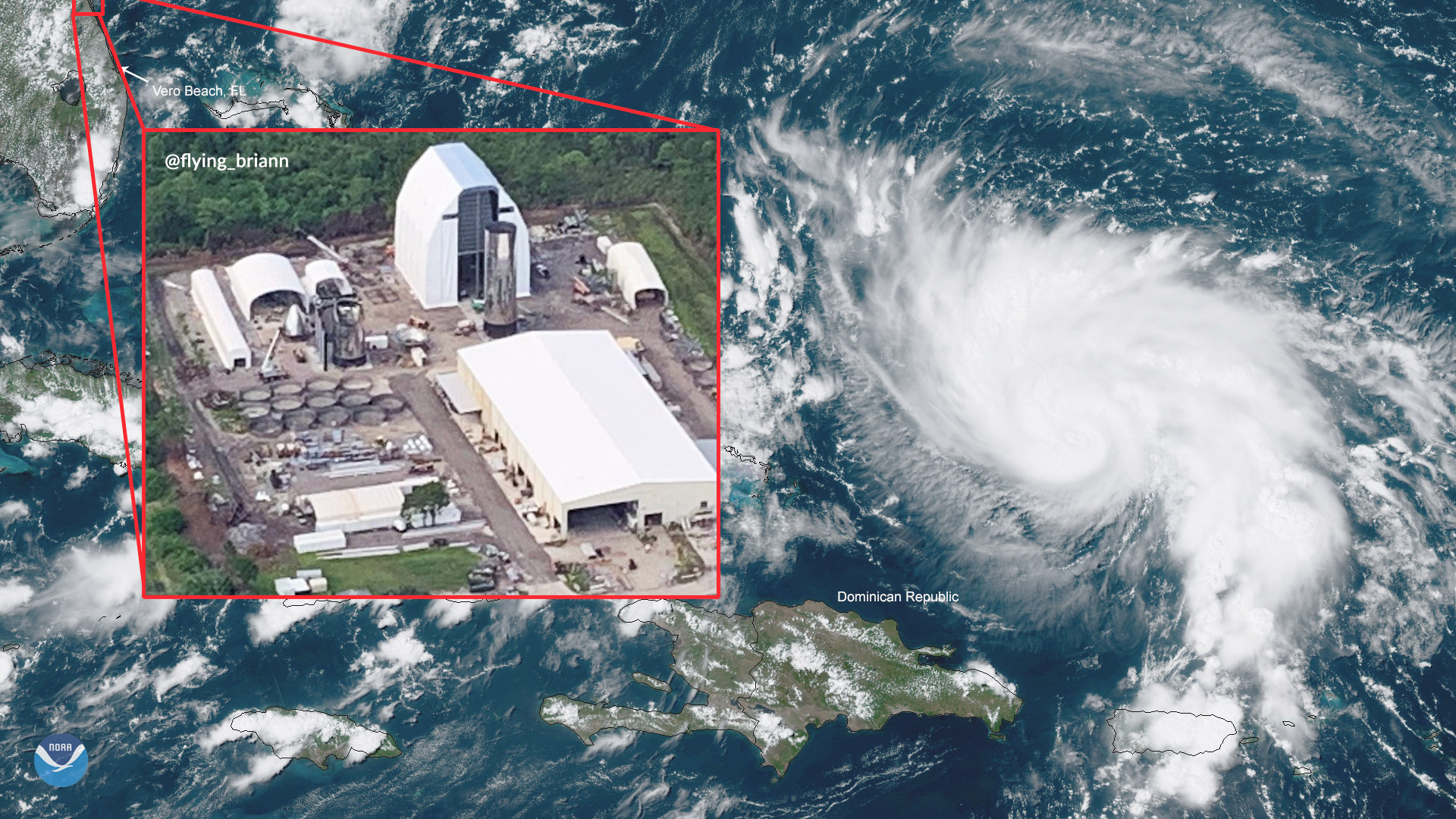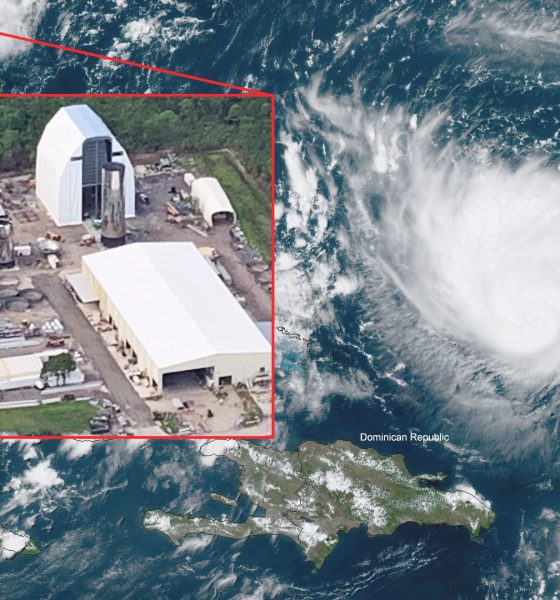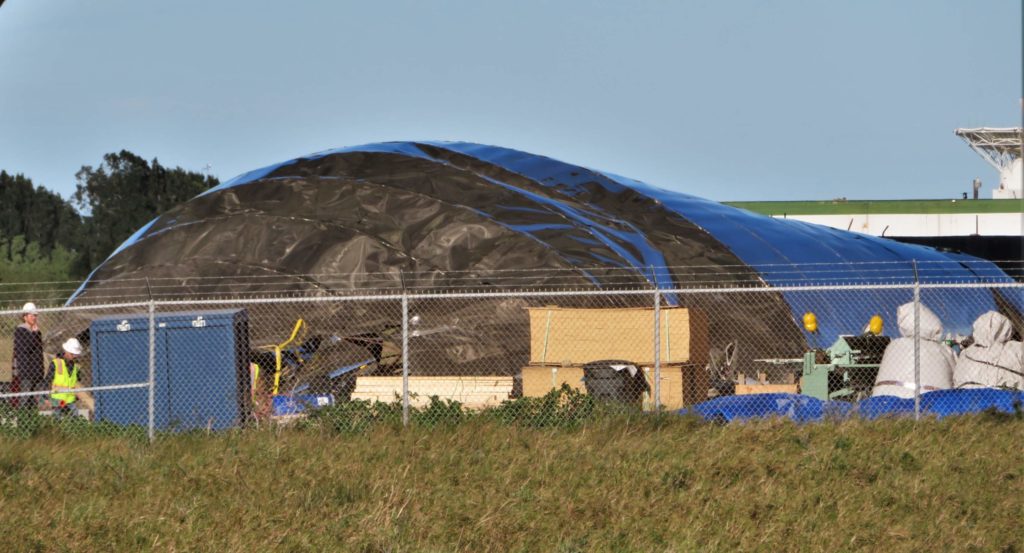

News
SpaceX braces for Florida-bound Dorian as hurricane threatens local Starship facility
Hurricane Dorian is currently growing into a potentially devastating Atlantic storm some 1,200mi (~2000km) off the Florida Coast and local spaceflight facilities – including SpaceX’s launch pads and Starship campus – are at high risk.
As of the latest storm advisories, Hurricane Dorian is likely to grow into a Category 3 or 4 storm prior to making landfall somewhere along the East Coast of Central Florida. Dorian’s ground track forecast is unusually uncertain just four days out from landfall, but the Space Coast’s Kennedy Space Center (KSC), Cape Canaveral Air Force Station (CCAFS), and other local spaceflight facilities (including SpaceX’s) are at high risk and are preparing for a worst-case scenario.
HURCON V – I
As of 0800hrs Wednesday morning, Brigadier General Doug Schiess – Commander of the 45th Space Wing at Cape Canaveral Air Force Station and Director of the Eastern Range at Patrick Air Force Base – initiated HURCON V preparations across Cape Canaveral Air Force Station (CCAFS) and surrounding areas. This precaution is triggered when storm winds in excess of 50 knots (58mph) are measured fewer than 96 hours to landfall. While CCAFS hurricane operations begin 96h out from landfall, KSC’s preparations begin after HURCON IV, indicating that storm winds in excess of 50 knots (58mph) have been measured 72 hours out from landfall. All facilities then follow a HURCON IV – I warning system that defines a series of preparation events and personnel evacuation plans.
A HURCON IV issuance will see all personnel report for duty as usual while specialized teams will begin implementing organization-specific checklists, vehicles are fueled, and storm Ride-Out Team (ROT) personnel will be identified. From there as the storm approaches non-essential personnel will be evacuated, facilities will be secured, and roads will be closed. ROT personnel will remain on-site and will begin the evaluation of the premises once the storm has passed.
SpaceX follows KSC’s lead, battens down Starship hatches
As SpaceX leases Launch Complex 39-A from KSC it is expected that they will follow all precautions initiated by KSC as they did almost two years ago amid launch preparations during HURCON III conditions while facing down Hurricane Irma. SpaceX has released an official statement confirming the obvious: the company is working closely with KSC and CCAFS to monitor weather conditions and plan to take all necessary precautions before, during, and after landfall.
SpaceX may not be new to preparing its Florida launch facilities for hurricanes and tropical storms, but Hurricane Dorian poses entirely new challenges due to the fact that the company has recently begun operating a fairly extensive Starship production facility in Cocoa, Florida. The vast majority of Cocoa’s work is done entirely out in the open, rarely protected by more than a spartan windbreak or temporary tent. According to local photographer Greg Scott, SpaceX has paused all Starship production work for the moment and is working all-out to secure its facilities as the potentially catastrophic Cat 4 Hurricane Dorian fast approaches.
The total lack of hurricane-rated protection puts SpaceX’s Starship facility at exceptionally high risk. The Cocoa production facility is thus facing many obstacles with hurricane preparedness as the majority of Starship production takes place outside and is completely vulnerable to the elements. Aerial photos depict what a daunting – if not utterly impossible – task it will be to secure all of the current production pieces of Starship Mk2.
Along with the main section structures and the completed nose cone section of Starship, many smaller fabrication pieces including large steel rings, a large bulkhead, and an array of assembly tools will need to be secured. Luckily a newly constructed wind guard structure covered in a white canvas material seemingly just reached completion and may be used to house the largest section of Starship if teams can manage to move it inside before storm conditions arrive.
Although it is surely going to suffer some damage from hurricane-force winds, the tent structure should offer some limited protection for any hardware that can be moved inside it. While Starship is being fabricated to withstand the stresses of launch and re-entry conditions, it may not be able to stand against the fury of a hurricane in its current fragile state.
Been here before…
SpaceX has faced damage to Starship prototypes at the hand of wind before. The first prototype – now known as Starhopper – constructed at their testing facility in Boca Chica, TX originally featured a tall nose cone portion that was ultimately lost. A storm that brought 50mph (80 km/h) wind gusts blew through and knocked the fairing piece off of its concrete stand and resulted in a completely crumpled heap of steel mess. The loss of the nose cone ended up being purely aesthetic and caused little to no setback to Starhopper testing – delayed instead by issues with Raptor engines.

Any damage suffered in Cocoa as an effect of Hurricane Dorian will almost certainly cause setbacks for SpaceX. Even if SpaceX gets extremely lucky and suffers no direct damage from a glancing blow, disruption to local infrastructure (power, waste, water, industry) could significantly hamper production operations. In the event that Dorian makes landfall at or near Cape Canaveral, Starship Mk2 and the many Super Heavy-related steel rings and facilities situated around the Cocoa campus could easily be destroyed or damaged beyond salvage, owing to the fact that they are made out of relatively thin and lightweight metal and have expansive, sail-like surface areas.
On the plus side, if any of the above does occur, SpaceX is simultaneously building a second near-identical prototype – Starship Mk1 – at its Boca Chica, Texas facilities. Disruption is undesirable, but SpaceX and its Starship program will likely (and hopefully) be largely unharmed. Additionally, SpaceX’s next Falcon 9 launch out of Florida is an internal Starlink mission scheduled no earlier than late October, leaving at least 1.5-2 months for clean-up and any necessary repairs.
Check out Teslarati’s Marketplace! We offer Tesla accessories, including for the Tesla Cybertruck and Tesla Model 3.

News
Tesla FSD fleet is nearing 7 billion total miles, including 2.5 billion city miles
As can be seen on Tesla’s official FSD webpage, vehicles equipped with the system have now navigated over 6.99 billion miles.

Tesla’s Full Self-Driving (Supervised) fleet is closing in on almost 7 billion total miles driven, as per data posted by the company on its official FSD webpage.
These figures hint at the massive scale of data fueling Tesla’s rapid FSD improvements, which have been quite notable as of late.
FSD mileage milestones
As can be seen on Tesla’s official FSD webpage, vehicles equipped with the system have now navigated over 6.99 billion miles. Tesla owner and avid FSD tester Whole Mars Catalog also shared a screenshot indicating that from the nearly 7 billion miles traveled by the FSD fleet, more than 2.5 billion miles were driven inside cities.
City miles are particularly valuable for complex urban scenarios like unprotected turns, pedestrian interactions, and traffic lights. This is also the difference-maker for FSD, as only complex solutions, such as Waymo’s self-driving taxis, operate similarly on inner-city streets. And even then, incidents such as the San Francisco blackouts have proven challenging for sensor-rich vehicles like Waymos.
Tesla’s data edge
Tesla has a number of advantages in the autonomous vehicle sector, one of which is the size of its fleet and the number of vehicles training FSD on real-world roads. Tesla’s nearly 7 billion FSD miles then allow the company to roll out updates that make its vehicles behave like they are being driven by experienced drivers, even if they are operating on their own.
So notable are Tesla’s improvements to FSD that NVIDIA Director of Robotics Jim Fan, after experiencing FSD v14, noted that the system is the first AI that passes what he described as a “Physical Turing Test.”
“Despite knowing exactly how robot learning works, I still find it magical watching the steering wheel turn by itself. First it feels surreal, next it becomes routine. Then, like the smartphone, taking it away actively hurts. This is how humanity gets rewired and glued to god-like technologies,” Fan wrote in a post on X.
News
Tesla starts showing how FSD will change lives in Europe
Local officials tested the system on narrow country roads and were impressed by FSD’s smooth, human-like driving, with some calling the service a game-changer for everyday life in areas that are far from urban centers.

Tesla has launched Europe’s first public shuttle service using Full Self-Driving (Supervised) in the rural Eifelkreis Bitburg-Prüm region of Germany, demonstrating how the technology can restore independence and mobility for people who struggle with limited transport options.
Local officials tested the system on narrow country roads and were impressed by FSD’s smooth, human-like driving, with some calling the service a game-changer for everyday life in areas that are far from urban centers.
Officials see real impact on rural residents
Arzfeld Mayor Johannes Kuhl and District Administrator Andreas Kruppert personally tested the Tesla shuttle service. This allowed them to see just how well FSD navigated winding lanes and rural roads confidently. Kruppert said, “Autonomous driving sounds like science fiction to many, but we simply see here that it works totally well in rural regions too.” Kuhl, for his part, also noted that FSD “feels like a very experienced driver.”
The pilot complements the area’s “Citizen Bus” program, which provides on-demand rides for elderly residents who can no longer drive themselves. Tesla Europe shared a video of a demonstration of the service, highlighting how FSD gives people their freedom back, even in places where public transport is not as prevalent.
What the Ministry for Economic Affairs and Transport says
Rhineland-Palatinate’s Minister Daniela Schmitt supported the project, praising the collaboration that made this “first of its kind in Europe” possible. As per the ministry, the rural rollout for the service shows FSD’s potential beyond major cities, and it delivers tangible benefits like grocery runs, doctor visits, and social connections for isolated residents.
“Reliable and flexible mobility is especially vital in rural areas. With the launch of a shuttle service using self-driving vehicles (FSD supervised) by Tesla in the Eifelkreis Bitburg-Prüm, an innovative pilot project is now getting underway that complements local community bus services. It is the first project of its kind in Europe.
“The result is a real gain for rural mobility: greater accessibility, more flexibility and tangible benefits for everyday life. A strong signal for innovation, cooperation and future-oriented mobility beyond urban centers,” the ministry wrote in a LinkedIn post.
News
Tesla China quietly posts Robotaxi-related job listing
Tesla China is currently seeking a Low Voltage Electrical Engineer to work on circuit board design for the company’s autonomous vehicles.

Tesla has posted a new job listing in Shanghai explicitly tied to its Robotaxi program, fueling speculation that the company is preparing to launch its dedicated autonomous ride-hailing service in China.
As noted in the listing, Tesla China is currently seeking a Low Voltage Electrical Engineer to work on circuit board design for the company’s autonomous vehicles.
Robotaxi-specific role
The listing, which was shared on social media platform X by industry watcher @tslaming, suggested that Tesla China is looking to fill the role urgently. The job listing itself specifically mentions that the person hired for the role will be working on the Low Voltage Hardware team, which would design the circuit boards that would serve as the nervous system of the Robotaxi.
Key tasks for the role, as indicated in the job listing, include collaboration with PCB layout, firmware, mechanical, program management, and validation teams, among other responsibilities. The role is based in Shanghai.
China Robotaxi launch
China represents a massive potential market for robotaxis, with its dense urban centers and supportive policies in select cities. Tesla has limited permission to roll out FSD in the country, though despite this, its vehicles have been hailed as among the best in the market when it comes to autonomous features. So far, at least, it appears that China supports Tesla’s FSD and Robotaxi rollout.
This was hinted at in November, when Tesla brought the Cybercab to the 8th China International Import Expo (CIIE) in Shanghai, marking the first time that the autonomous two-seater was brought to the Asia-Pacific region. The vehicle, despite not having a release date in China, received a significant amount of interest among the event’s attendees.








